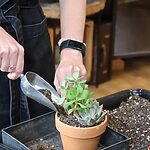Hoya Callistophylla Wax Plant
When provided with the right conditions, the Hoya Callistophylla rewards you with clusters of star-shaped, fragrant flowers that bloom in creamy white with pinkish centres, adding even more charm to this stunning plant.
Hoya i is also pet-friendly, making it a safe addition to homes with cats and dogs. Its hardy and low-maintenance nature means it can handle periods without water and thrives with minimal care, making it an ideal choice for beginners and busy plant enthusiasts alike.
Please note that the images shown represent the actual stock. Minor cosmetic imperfections on the leaves are natural for live plants and do not affect the plant’s health or growth potential.
The genus Hoya includes over 500 recognised species (the number varies greatly due to discrepancies within the group and new species being discovered). Most Hoya plants are originally from Asia, Australasia, and the Pacific islands. Botanist Robert Brown named the Hoya genus after his friend Thomas Hoy.
Hoya species are found in rainforest, coastal and cliff habitats, where they may grow climbing on other plants (this pattern is also known as epiphytic), forming vines and, occasionally, shrubs.
- How often should I water my Hoya Callistophylla?
- Water the plant when the top inch of soil feels dry, typically once every week or two, depending on environmental conditions. Be cautious not to overwater, as Hoya prefers the soil to dry out between watering sessions.
- Can the Hoya Callistophylla thrive in a bathroom environment?
- Yes, this Hoya can do well in a bathroom if it has access to bright, indirect light. The higher humidity of this environment can promote more vigorous growth and flowering.
- Is the Hoya Callistophylla suitable for beginners?
- Absolutely! Its low-maintenance and drought-tolerant nature make it an ideal choice for beginners. It requires minimal care, tolerating occasional neglect, and still thrives.
☀️ Light
☀️☀️▫️ (Medium)
The Hoya Callistophylla thrives in bright, indirect light but can also handle a few hours of direct sunlight daily. Too much direct sun might scorch its leaves, so it’s best to find a spot where sunlight is filtered through a sheer curtain or partially shaded by other plants.
💧 Water
💧▫️▫️ (Low)
This plant is quite drought-tolerant, perfect for those who might forget to water now and then. Allow the soil to dry out completely between waterings. Overwatering can lead to root rot, so ensure good drainage and err on the side of underwatering rather than overwatering.
🌡️ Temperature
🌡️🌡️🌡️ (Warm)
Hoya Callistophylla enjoys warm environments, thriving best between 18-26°C. Avoid placing it near drafty windows or doors during the chilly months, as cold drafts can stress the plant.
💦 Humidity
💦💦▫️ (Moderate)
While it can tolerate average indoor humidity, the Hoya Callistophylla appreciates a boost in humidity levels. If you notice the tips of the leaves becoming brown and dry, try increasing humidity through regular misting, using a pebble tray, or placing a humidifier nearby.
🪴 Repotting (or substrate info for moss/creatures)
Preferably slightly root-bound, the Hoya Callistophylla doesn’t require frequent repotting—usually only every 2-3 years, or when it visibly outgrows its pot. Use a well-draining potting mix, ideally a blend designed for succulents or epiphytic plants, which you can find right here at Highland Moss.
🐾 Pet Friendliness
This plant is non-toxic and safe for homes with furry friends, making it an excellent choice for pet owners who want to keep both their pets and plants happy and healthy.
✅🪴 Recommended Locations at Home
Place your Hoya Callistophylla in living rooms or offices where it can enjoy ambient light without direct sun exposure. Hanging baskets or high shelves are perfect as they allow the trailing vines to cascade beautifully.
🌬️🪴 Air Purifying
While hoyas are not specifically known for their air-purifying abilities, they do contribute to a healthier indoor environment by adding moisture to the air and potentially reducing airborne microbes.
✨ Other Plant Features
This striking plant not only beautifies your space with its lush, veiny leaves but also with seasonal clusters of star-shaped, fragrant flowers, providing both visual appeal and a delightful scent.
If you have any more questions, feel free to ask Mossbot for help, contact us via our website, or take advantage of our free plant hospital service if your Hoya Callistophylla needs extra care.

Free Care Guide With Every Purchase
Scan the plant pot QR for instant access to our care guide for your plant. No hassle, no stress, just healthy and happy plants.
Verified reviews from our customers
| 5 star | 96% | |
| 4 star | 3% | |
| 3 star | 1% | |
| 2 star | 0% | |
| 1 star | 0% |




















excellent packaging and service, prompt reply to a query.
Everything was very well packed.
A great website, with some beautiful items that are well presented. Perfect free gift provided and delivery was super quick, with good packaging too! Thank you.
Arrive quickly, well packaged and exactly as described, although the post office clearly missed the huge, live plant, and fragile stickers🤣
Very fast delivery, website easy to navigate